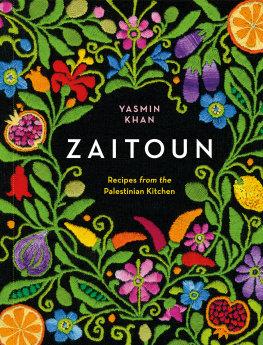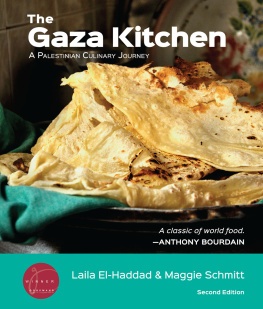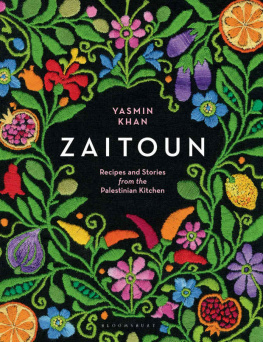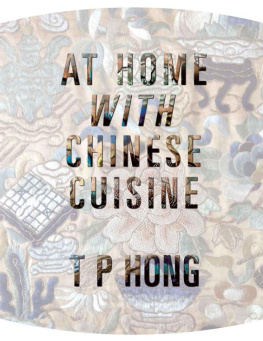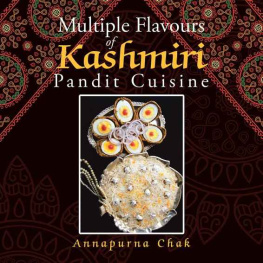CLASSIC PALESTINIAN CUISINE
CLASSIC PALESTINIAN CUISINE
Christine Dabdoub Nasser
SAQI
CONTENTS





INTRODUCTION
Traditional Palestinian cuisine offers a rich variety of dishes characteristic of the eastern regions of the Mediterranean.
At a crossroads between East and West and a strategic post on the trading routes for centuries, Palestine has had its share of invasions and occupations by foreign forces. If such a tumultuous history has marked the national psyche, it has certainly served to enrich the Palestinian experience, conferring upon it the cosmopolitanism that distinguishes it from neighbouring Arab cultures, while strengthening the base that roots it deeply within the civilisations common to this geographic area. Modern-day Palestine is identified with a variety of lifestyles that cover a wide range, from nomadic migration to urban sophistication.
The establishment of many foreign communities who settled in the Holy Land in the aftermath of the Crimean War in 1855 has also contributed to the present character of Palestinian cuisine, especially in urban centres such as Jerusalem, Jaffa, Ramallah and Bethlehem. In its most recent history, especially during the last fifty years, the demographic changes that have swept the area have influenced culinary trends both directly and indirectly and although the scope of such influences is still to be determined, it cannot be dismissed or underestimated.
Palestinian cuisine, as an expression of this diversity and manifold social and cultural make-up, has shouldered the tides through integration rather than rigid resistance. Staple Palestinian dishes, based primarily on rice as a main ingredient, are a dramatic expression of this osmosis, as rice has always been an imported commodity. The cuisine of the Bethlehem area has evolved more dramatically than that of other cities, the main reason being its close proximity to Jerusalem, quite the international city since the second half of the nineteenth century, but also because Bethlehem has been exposed to outside influences in its own right. Still, due to the many villages that dot the landscape towards the south and which have close ties to the city, Bethlehem has managed to maintain rustic attributes and to happily reconcile the rural with the urban, the sophisticated with the earthy, in a way that distinguishes it markedly from Jerusalem. The testimony of a nineteenth-century pilgrim to the Holy Land still holds true:
Finally, here is the city, lying in the hills and surrounded by green valleys. The white houses, vain and bright in the fading light of the setting sun, are reflections of marble against the intensity of the deep blue sky. Low walls of dry stones happily delineate the hilly slopes into terraces and gardens, cultivated in a manner henceforth unfamiliar to Jerusalem.
LAbb Landrieux, In the Land of Christ
Lamb holds a place of honour at every festive occasion. Throughout the year, in both affluent and modest circles where every occasion necessarily gives rise to celebration, the slaughtering of a lamb is one important component capturing whole categories of cultural and social symbols that gird the fabric of daily life. Lambs are slaughtered for weddings; the occasion of the birth of a son; recovery from a long and serious illness; the return of a long-absent family member or friend; the building of a new home; and even the acquisition of a new car. The celebration of Easter and Adha, two major feasts based on the concept of sacrifice for Christians and Muslims alike, are a culmination of this tradition and the extended family meets around the festive table where lamb occupies the centre place. In the last three decades this practice has somewhat weakened due to several factors: urbanisation and the consequent changes in perceptions and lifestyles; economic considerations which are closely tied to a dramatic rise in the cost of living; and health awareness. However, it still persists in conservative strongholds and, more particularly, in the northern villages of Palestine where adherence to traditional practices was one of the few means of cultural expression under Israeli hegemony during the last fifty years. It also remains constant during such solemn occasions as the loss of a family member or neighbour. If the consumption of lamb has receded in favour of leaner beef or white meat, especially chicken, it still remains the basic ingredient in the rich regional cuisine and no Palestinian would ever consider honouring a guest with anything but lamb.
Samneh baladieh, or clarified butter, is another feature particular to Palestinian cuisine. During the spring season, the only time of year when the hills and grazing grounds are green and the ewes have just given birth, ewes milk and ewes-milk cheese are sold door-to-door. Samneh is strained butter that has been boiled with cracked wheat, nutmeg and turmeric, a bittersweet spice that gives it its musky flavour and a distinctive bright yellow colour. It is one of those ingredients that cannot be bought off the shelves but has to be obtained through a network of contacts among the nomadic bedouins who breed the sheep and make the butter. The month of April witnesses the stir of housewives inquiring about prices and quality, and those who have a sure source of supply warrant their stock for the whole year before passing on the information to others. Again, due to dramatic hikes in prices and health considerations its use has been greatly reduced in favour of healthier sources of fat and many cooks use it in small amounts for flavour.
When the milk is churned to extract the butter, the by-product, laban mkheed, is also processed for year-round storage. This buttermilk is left to drip through cheesecloth for a few days. The resulting pasty cheese is then kneaded with salt, cumin and turmeric, shaped into balls and dried over a wooden board in a dark room for a few days then stored in cloth bags. Individual balls of laban jmeed, as it is called in its new state, are diluted as needed for sauces for many traditional dishes. Bedouins in the Bethlehem area substitute the cumin with fenugreek, a highly aromatic, somewhat bitter, spice.
Last but not least, it is the careful use of spices that will ultimately impart character to any cooking. The range of spices and herbs used in Palestinian cuisine has multiplied through the generations, but it is the repeated use of basic ingredients such as allspice, cinnamon, cumin and cardamom that gives Palestinian cuisine its own stamp. However, whether driven by strict adherence to traditional practices or strongly tempted to experiment and innovate in search of a personalised style, Chef Escoffiers adage to stay simple cannot be truer than when applied to the use of spices.
Simplicity can be certified through the quality of the spices. Careful selection a reliable attar or spice vendor is as important to secure as a good butcher and shopping in limited quantities according to your needs for no more than two months are essential. Spices should be bought whole, as grains, sticks or roots, and preserved in tightly closed containers away from any source of light or heat. Then they can be moulded, chipped or grated as needed. Luckily, buying spices in jars off a supermarket shelf is a luxury a Palestinian housewife can do without! The same goes for herbs; it is very useful to have a herb patch in the back garden or plant some select favourites in containers by the kitchen. Nothing equals the aroma of freshly picked herbs in a salad.




